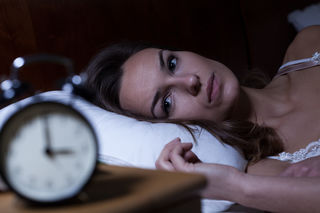Sleep
For the Best Sleep, Less Time in Bed Can Be More
Learn the sleep scheduling approach that optimizes sleep quality.
Posted March 13, 2018
How does your brain know when it's time to sleep? There are two main factors:
- Hours Awake. The longer you've been awake, the stronger your drive for sleep.
- Circadian Rhythm. Your body operates on a roughly 24-hour cycle, and is accustomed to sleeping at about the same time each night.
Your chances of sleeping well are maximized when these two factors are working in your favor. For example, if you're in the habit of going to bed at 10:30 pm and waking up at 6:00 am, your body will start to anticipate sleep as you approach 10:30; since you'll have been up for over 16 hours at that point, you'll probably have a strong sleep drive. Restful, restorative sleep is the most likely outcome.
In chronic insomnia, both of these components of the sleep drive tend to be disrupted. It often starts with acute sleep disturbance—maybe you're dealing with pain, you welcomed a new baby into your home, family stress has gripped your mind, or you're on a medication that interferes with sleep.
Whatever the cause, you're getting less sleep than you're used to. A common response to being sleep deprived is trying to make up the lost sleep by:
- Sleeping in
- Taking a nap
- Going to be early
What do all of these reactions have in common? Two things:
- They disrupt your circadian rhythm by introducing sleep at unexpected hours.
- They decrease your hours awake come bedtime
For example, say you're up till 1:30 am worrying about an issue at work. When your alarm goes off at 6:00 you turn it off and sleep till 8:00. As a result you've captured a couple more hours of sleep. But by the time 10:30 pm rolls around, you've only been awake for 14.5 hours, so your drive for sleep is decreased.
You might also decide to go to bed at 9:30 since you only got 6.5 hours of sleep, even with sleeping in. In that case you'll have been up for only 13.5 hours, and you'll be out of alignment with your circadian clock. So when you lie down to sleep your brain is unlikely to cooperate.

Sleep Anxiety
When we're not sleeping well, an almost universal response is to start worrying about sleep.
- Am I going to have a hard time falling asleep?
- Will I be awake for a long time in the middle of the night?
- Am I going to get enough rest?
- Will I be a wreck tomorrow?
These concerns do nothing to improve our sleep, and they're especially problematic when combined with a low sleep drive. We can end up spending hours awake in bed, trying desperately to fall asleep, yet fearing we'll have another night of insomnia.
Thus the more time we spend awake in bed, the more opportunity our brains have to associate the bed with being awake and frustrated. We might start to feel anxious as soon as we lie down for bed, or even earlier when we think about the night ahead.
Effective treatment can restore a strong drive for sleep while breaking the link between bed and anxiety. Let's see how it works.
Sleep Scheduling
One of the best tested ways to fix insomnia is called Sleep Restriction Therapy. It's effective on its own, though it's more often part of a comprehensive sleep program called cognitive behavioral therapy for insomnia (CBT-I; see this earlier post). The big idea is to carefully match the time we spend in bed with our "sleep ability," which is the average amount of sleep we're capable of per night.
Consider a man who's getting 6 hours of sleep on average, and is going to bed at 10:00 pm and getting up at 7:00 am. That's 9 hours in bed for 6 hours of sleep, meaning for every hour he spends in bed he's only sleeping 40 minutes. In sleep restriction terms his "sleep efficiency" is 67% (6 hours of sleep divided by 9 hours in bed).
Ideally we'd like sleep efficiency to be at least 85-90%, such that a person is asleep the vast majority of the time spent in bed. The man in the example above would plan to reduce his time in bed to 6 hours to match his average sleep ability (6.5 in some protocols, to allow for time to fall asleep and brief awakenings). If he has to be up at 7:00 am, that would mean going to bed at 1:00 am, 7 days a week.
Sleep restriction in this example fixes the two sleep drives we discussed above:
- Staying awake for 18 hours builds a strong need for sleep.
- Keeping a consistent sleep schedule trains a predictable circadian rhythm.
A person might fall asleep easily the first night of sleep restriction, though it may be hard because the body is still used to being wired when going to bed. The odds are greater on the second night as the need for sleep increases, and by the third and fourth night it's extremely unusual for a person to continue to lie in bed awake.
The idea of "restricting" sleep when we're battling insomnia can seem cruel, which is why I usually call it "sleep scheduling." In reality the total amount of sleep time might go down a little when we start restricting time in bed, but the sleep will be sounder and more restorative, and will increase over time (which I describe below).
How to Do It
Check with your doctor before trying sleep restriction to ensure it's a good fit for you.
Step 1: Log Your Sleep. For one to two weeks, keep track of your sleep, including:
- Time you went to bed
- How long it took to fall asleep
- How many times you woke up during the night
- How long each awakening lasted
- Your final wake-up time
- The time you got out of bed
Base your numbers on your best estimates, rather than watching the clock. Place your clock out of sight throughout the sleep restriction process so it's not an added source of sleep anxiety.
Step 2: Crunch Your Numbers. For each night, calculate how much sleep you got.
- Calculate the hours between when you fell asleep and your final wake-up time. For example, if you fell asleep at 11:00 pm and woke up at 5:30 am, that's 6.5 hours.
- Find the sum of your middle-of-night awakenings. For example, if you woke up 3 times for 10, 15, and 30 minutes, your awakenings lasted a total of 60 minutes.
- Subtract these awakenings from your sleep time. In this example, 6.5 hours minus 60 minutes is 5.5 hours.
Repeat this process for each night you recorded, then calculate their average by summing all nights and dividing by the number of nights. The number you get is your average sleep time per night.
Calculate your sleep efficiency for each night by first finding your time in bed, which is simply the number of hours between when you got in bed and when you got out of bed at the end of the night. Then divide your sleep time for that night by your time in bed. Do this for each night and take the average.
If you want to make it easy on yourself, there are apps that make recording and summarizing your sleep data quick and easy (e.g., RESTORE, which is free).
Step 3: Set Your Sleep Schedule. Determine when you need to get up for the day. Let's say it's 6:30 am. If your average sleep time is 6.5 hours, you'll need to hit the hay at 12:00 midnight. Set an alarm to get up at 6:30 so you won't oversleep and deplete your sleep drive, and so you won't wake yourself up early wondering if you overslept.
Step 4: Follow Your Schedule Consistently. It can be tough early on to follow this sleep schedule every night, especially before one's sleep has started to consolidate. The closer you stick to this schedule, the faster your sleep will improve. Continue to track your sleep each night.
Step 5: Reassess Your Sleep. After a week of sleep restriction, repeat the calculations to see how your sleep is doing on average. If your sleep efficiency is good—in the 85-90% range, or higher—then give yourself an additional 15 minutes in bed each night. If you were going to be at midnight, start going to bed at 11:45 pm. It's important not to add too much time in bed too quickly so sleep doesn't get fragmented again.
Step 6: Continue the Process. Keep recording your sleep numbers and adding time in bed each week if your sleep efficiency stays high, and if you could still use more sleep. If at any point your sleep starts to deteriorate, simply reduce the time you're spending in bed to a level that was working better for you.
I've seen so many men and women fix their sleep using this approach, and in fact have used it myself at times. If you're suffering from insomnia and are spending hours in bed awake, consider whether this approach might be right for you.
References
American Academy of Sleep Medicine. (2006). Practice parameters for the psychological and behavioral treatment of insomnia: An update. An American Academy of Sleep Medicine report. Sleep, 29, 1415-1419.




